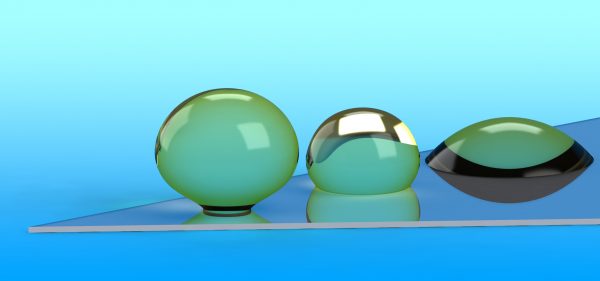TORONTO, October 4, 2016 – Canadian Olympic phenomenon Penny Oleksiak may be able to glide through the water even faster at her next Olympic Games, due in part to a new measurement tool invented by York University researchers.
“We asked ourselves the basic question: ‘how does liquid spread on a surface?’, be it Penny’s swimsuit while underwater, or the morning dewdrops on grass,” says Sushanta Mitra, a professor in York’s Lassonde School of Engineering. “Oleksiak’s exceptional ability in the pool is undeniable. A more advanced suit could help her beat her personal best by reducing fluid resistance underwater.”

The three stages of drop spreading on any surface.
Mitra’s research has resulted in a new technique that measures the rapid process of liquid drops spreading on any surface. Interface scientists in his Micro & Nano-scale Transport (MNT) lab at York U have created an experimentation tool with funding from the Natural Sciences and Engineering Research Council (NSERC). The tool, built with an optical path using specialized microscopic lenses, captures the bottom view and side view of a spreading drop. It enabled researchers to observe the initial stages of a drop spreading on any surface inside a glass container filled with water.
“Since water is a viscous medium, the spreading process was significantly slowed, which allowed us to discover the initial regime. This is the first time this process has ever been measured,” says Mitra, whose team also performs breakthrough translation research in water quality monitoring. “Soon we’ll have new and improved products in water-repellant coatings, materials with underwater drag reductions and the like, on the market,” says Mitra.
Traditional drop spreading experiments are conducted in air and there needs to be a few nanometer resolution to accurately characterize the initial stage of the process. That is below the physical limit of current optical systems used in experiments, according to co-author Surjyasish Mitra, whose graduate studies at York focus on fluid dynamics. “We overcame the challenges of conducting experiments underwater by using the new tool which brought down the length scale to micron levels.”
The study, “Understanding the Early Regime of Drop Spreading,” is published as the cover feature in peer-reviewed journal for fundamental interface science Langmuir.
Images for media use:
- The three stages of drop spreading on any surface
- The side view of drop spreading (vertical plane) and the corresponding bottom view (horizontal plane) of drop from initial stage to its final equilibrium position
York University is known for championing new ways of thinking that drive teaching and research excellence. Our students receive the education they need to create big ideas that make an impact on the world. Meaningful and sometimes unexpected careers result from cross-discipline programming, innovative course design and diverse experiential learning opportunities. York students and graduates push limits, achieve goals and find solutions to the world’s most pressing social challenges, empowered by a strong community that opens minds. York U is an internationally recognized research university – our 11 faculties and 26 research centres have partnerships with 200+ leading universities worldwide. Located in Toronto, York is the third largest university in Canada, with a strong community of 53,000 students, 7,000 faculty and administrative staff, and more than 295,000 alumni.
York U's fully bilingual Glendon campus is home to Southern Ontario's Centre of Excellence for French Language and Bilingual Postsecondary Education.
Media contact:
Gloria Suhasini, Media Relations, York University, 416 736 2100 ext. 22094, suhasini@yorku.ca

